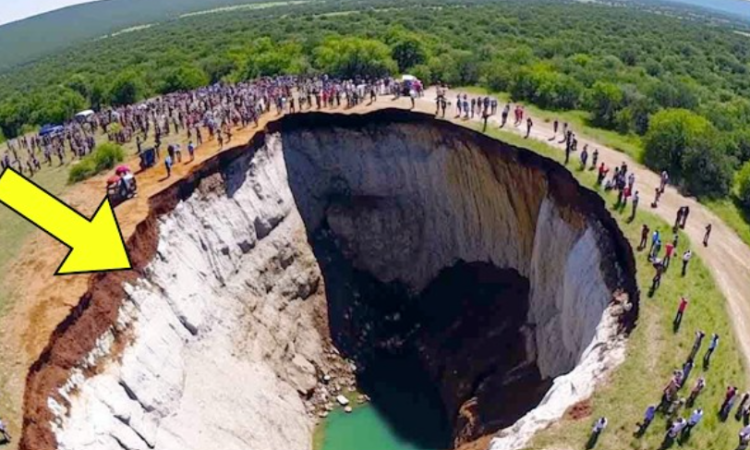
When Albert Wrighes went out to mow his lawn, the last thing he expected was that the ground would cave beneath him. It turns out Albert and the rest of his neighbors were living on top of a sinkhole. Even more surprising was what the hole led to underground.
It was a day like any other in Blackhawk, South Dakota. Resident Albert Wrighes was out mowing his lawn like he had so many times before. Then something happened that changed everything. The man felt something strange underfoot. The 56-year-old man carefully turned around to see what could be going on. When Albert turned around, he could hardly believe his eyes. Only a foot behind him was the beginning of a giant sinkhole that had caved in out of nowhere.
What does one do when their property collapses into a sinkhole? What Albert did was bolt to the neighbor’s house. He knocked on the door of John Trudeau, who had also been experiencing some unusual happenings. John had already suspected something was amiss that morning because the faucet had suddenly stopped working. Albert’s story was enough to make this an official emergency. John’s wife hurriedly called 911.
As it turns out, they weren’t the only neighbors impacted. When the authorities arrived, they moved quickly to get everyone to safety. That’s when they discovered that the sinkhole near Albert’s home wasn’t the only one. Another sinkhole appeared right across the street. Right away, six families were evacuated. That number would double once the experts determined the cause of the sinkholes. But finding that answer didn’t require officers; it required cavers.
When caver Adam Weaver heard about what had happened to the neighborhood, he volunteered to check it out. Adam is a part of Paha Sapa Grotto, a subchapter of the National Speleological Society, aka people who study caves. Adam, who holds a master’s degree in natural resource stewardship, offered to try and map out what he thought was a natural sinkhole. When he arrived with his team, they soon discovered that they were in over their heads.
When Adam and the rest of the Paha Sapa team inched their way into the sinkhole, they quickly realized that it wasn’t at all what they’d expected. They came to find out that the hole led to an abandoned gypsum mine. The mine was more than 600 feet long and still had drilling holes and mining gear in it. Even though Adam knew that there was a lot of gypsum in the area, it never dawned on him that there might be an abandoned mine down there. It probably escaped his awareness because the mine was decades old. It had first opened in the 1920s and closed three decades later. Still, there remained old items such as a mining handcart. They also found bones, which Adam’s wife, a paleontologist, confirmed belonged to a calf.
Another member of Paha Sapa Grotto, Christopher Pilari, echoed this sentiment in his interview with SDPB Radio. Christopher said, “Being experienced at traveling underground, we were cautious to go in, but we recognized somebody needed to do this, and we’re the ones that have expertise in that area.”
Coming up, the cavers had never come across this finding before. The crew at Paha Sapa Grotto carefully made their way further into the mine, making incredible discoveries along the way. They could still see the old rail car tracks that were used when the mine was still operable. Even the natural elements in the cave held a certain mystery.
As interesting as all of the findings the team was making were, they were also items to be expected in an abandoned mine: old tools, animal remains, deteriorating wood. Much to the cavers’ surprise, there was a car hanging down from the top of the mine. It was wedged between rocks and appeared to have fallen into a hole from the surface. Christopher described it as “half sticking out of the ceiling, basically.” However, this wasn’t a newer car; the vehicle was actually a 1954 Ford Crestline Sunliner.
The group was amazed to see such a thing in the mine and started speculating about what happened. By everyday standards, the car looked like it came out of a junkyard. The windows were all missing, the paint was severely damaged, and there was rust all over. Still, Adam notes that it’s in super good shape given what it’s been through. It’s true that the car could have been much more jumbled. It could have rolled down the rocks and been banged up or smashed.
That brings up the question: what exactly has the vehicle been through? The team conjured up two possibilities regarding how the Ford got there. The first is that the car fell into the mine after it had closed due to a sinkhole. The second is that it had been there the whole time. It could have belonged to one of the workers and ended up getting trapped in the mine. The Ford’s origin story will likely remain a mystery since Adam thinks it probably won’t ever come out.
Finding the 1954 Ford Crestline Sunliner was a big surprise for the entire group. Adam told Hagerty that the experience was amazing. Even more amazing, though, was what they found next. As though one vehicle wasn’t jarring enough, the team ended up stumbling upon another one. Adam confirmed that there was also a truck in the mine, adding that it was even older than the car. The truck was positioned nose-down and too inaccessible to photograph.
As incredible as the group’s findings were, they had to get down to business and accomplish what they went there to do: map the mine. They measured 2,300 linear feet of passages, and that’s just where they were able to reach. There were still other tunnels that had collapsed or flooded and therefore couldn’t be mapped. They also found some tunnels to be upwards of 40 feet wide. The ceilings ranged from 12 to 30 feet tall.
While the mine investigation led to some answers, there was still plenty of information needed to uncover how all this happened. That’s where Doug Huntrods came in, the emergency manager for Meade County, where Blackhawk is located. At a press conference, Doug revealed that the Dakota Plaster Company had owned the mine. This makes perfect sense, considering gypsum is commonly used in plaster. Additionally, the Rapid City Journal found in their archive that they’d covered the Dakota Plaster Plant opening back in 1910.
Coming up: This is what the displaced families are doing about their lost homes. As fascinating as the gypsum mine is, the finding is bittersweet for those whose homes are now at risk due to safety hazards. A total of 12 families were displaced due to the sinkholes, totaling between 30 and 35 individuals.
John Trudeau, the neighbor who Albert Wrighes ran to when his lawn caved in, brought up a question that many of the neighbors are likely pondering: did the developers know and turn a blind eye? The question of who is responsible is especially crucial since insurance companies are refusing to cover the damage or pay for the cost of the lost home. Both John and Albert reported that this was the case for their insurance companies, who simply told them that their policies don’t cover underground sinkholes. As a result, many of the displaced families have turned to GoFundMe to try and raise money to at least help make ends meet for the time being.
Meade County did make an effort to get funds from the Federal Emergency Management Agency (FEMA) to help the families that no longer have their homes. However, these discouraged residents have still included county officials in their lawsuit. That’s because public records indicate the Meade County Planning Board knew of the mine’s existence when they approved the neighborhood development. The lawsuit is also aimed at the state real estate agents and developers, all of whom should have been made aware of the dangers. The mine not only posed a risk for the neighborhood but also for a nearby interstate. As a result, engineers had to inspect I-90 to ensure that there wasn’t a threat of sinkholes near the highway. After inspecting 1,500 feet of the road and 60 feet underneath, the experts confirmed that the road is safe from the underground mine.
Now that the road is handled, the county can put their full attention toward the residents and decide what to do about this surprising find. Sinkholes are always a surprise, but in cases like this one, what was found in the sinkhole was even more incredible.
Across the world, in April 2020, a sinkhole formed in front of the historic Pantheon in Rome, Italy. While the sinkhole itself was a marvel to look at, what was truly amazing was what was discovered beneath the earth. The sinkhole that appeared in the middle of Rome was discovered in front of the Pantheon, a house of worship used continuously since it was first constructed back 2,000 years ago. It is located in Rome’s Piazza della Rotonda, which is exactly where a 10-square-foot section of the earth collapsed on itself, opening a hole in the ground.
After the sinkhole emerged, nobody knew exactly what the archaeologists would find once they began sifting through the rubble. Although the sinkhole in front of the Pantheon can be considered unique, sinkholes around Rome aren’t all that uncommon. This is mainly because the city is so old that all the ancient quarries, tunnels, and catacombs built in the past eventually collapsed after all those thousands of years. Particularly in the eastern region, Rome has countless hidden cavities beneath the cobblestone streets that used to be mined, which are now full of history and waiting to be discovered. Sinkholes in the Eternal City can sometimes reach over 100 in just the passing of one year. Nevertheless, not many of them become as popular as the hole that emerged in front of the Pantheon in April 202
0.
Many of the American state capital buildings have also drawn inspiration from the Pantheon’s design. On top of impressing some of the Renaissance’s most renowned artists, it became a popular burial site for many people of importance during that time because it was made into a Catholic Church. This includes the painter Raphael and some Italian monarchs. Today, tourists from all over the world come to see the incredible architecture and the grave sites of some incredibly notable individuals from the past. So it’s no surprise that there was more history beneath the earth.
The modern-day Rome area has been inhabited by humans for thousands of years, even before it became a civilized city. So, understandably, a lot of this history has been lost beneath the ground. This includes a network of quarries mined by the ancient people. The miners also dug cavities, tunnels, and catacombs that are causing the sinkholes in Rome today. Another thing that creates the sinkholes is the loose soil that the city’s foundation is built on.
The sinkhole opened up in front of the Pantheon in April 2020, starting out as a 10-square-foot hole that was 8 feet deep. Although the hole itself was big compared to everything that lies beneath Rome’s city, it was only a fraction of what could be discovered. Nevertheless, the hole provided some key insight into Rome’s past.
A team of archaeologists from ANSA took up the role of investigating the sinkhole, unsure of what they might find. When the archaeologists from ANSA first made their way into the sinkhole, they discovered paving stones that dated far back to ancient times when Rome was the capital of the Empire. In total, there were seven of these stones, which were dated to be around 25 to 27 BC. Interestingly, 27 BC was also the same year as the Empire’s creation. But what else would these inquisitive archaeologists discover beneath the ground?
As we already know, Agrippa built the first Pantheon in Rome around the same time, 25 BC to be exact, while his father-in-law Augustus served as Rome’s first emperor. From this information, historians concluded that the ancient slabs of stone were part of Agrippa’s first temple’s work. What makes it even more fascinating is that Agrippa helped design the stones himself. The archaeologists were astounded by this discovery, knowing they were standing right on top of history.
After the first Pantheon, built by Agrippa, had burned down, Hadrian had a new one built in its place, one of his many architectural achievements. Furthermore, he also ensured that the surrounding piazza was refurbished. The piazza and Pantheon underwent further renovations at the beginning of the 200s, which pushed the original stones used deep into the ground.
However, this wasn’t the first time that these ancient stones had been unearthed during the modern age. In the 1990s, workers were laying a brand-new network of service cables that ran through an underground tunnel. It was during this project that they found the travertine stonework laid by the ancient Romans. While this was still an incredible find in the 1990s, what made the discovery in April 2020 that much more fascinating was that they had been found due to a sinkhole. It was almost as if they wanted to be found.
When the stones were initially found by those working on the service cables in the 1990s, they were examined and then reburied. Nevertheless, they were buried with a layer of pozzolana on top. The superintendent of Rome, Daniela Porro, explained in a statement that pozzolana is a material that is similar to cement when wet. So adding a layer on top after returning the stone to the earth acts as a form of protection from damage over time.
When the stones were once again uncovered in April 2020, Porro made sure to mention how the pozzolana had successfully protected the artifacts. In a statement in May 2020, she commented that it was “an unequivocal demonstration of how important archaeological protection is, not only an opportunity for knowledge but fundamental for the preservation of the testimonies of our history, an invaluable heritage, particularly in a city like Rome.”
Because of all of their planning and preservation tactics that were put in place to protect the stones, the Romans were lucky regarding the timing of the Pantheon sinkhole finally opening up. To help correct the problem, in March 2018, the city announced its plan to fix the more than 50,000 potholes that riddled the city to prevent them from opening into sinkholes. The mayor, Virginia Raggi, designated a 17-million-euro (more than $20.5 million) budget to put the project into action and stop future problems.
When Raggi first announced her new plan to fix the potholes, she promised that 50,000 of them would be filled and fixed within the first month of the program. Yet, since the spring of 2020, the project has been delayed significantly. Because of this, potholes still remain a great danger to both the thousands of citizens and tourists of Rome who walk the streets every day. Furthermore, sinkholes have continued to form due to a lack of maintenance.
Although the sinkhole in front of the Pantheon was all the buzz for a while, it wasn’t the only sinkhole to open up near one of Rome’s most historic locations. In January 2020, one of these craters opened up on Via Marco Aurelio, which is very close to the iconic Colosseum. As a result, city officials had to evacuate an entire apartment building as they closely inspected the safety of the ground surrounding the new hole.




